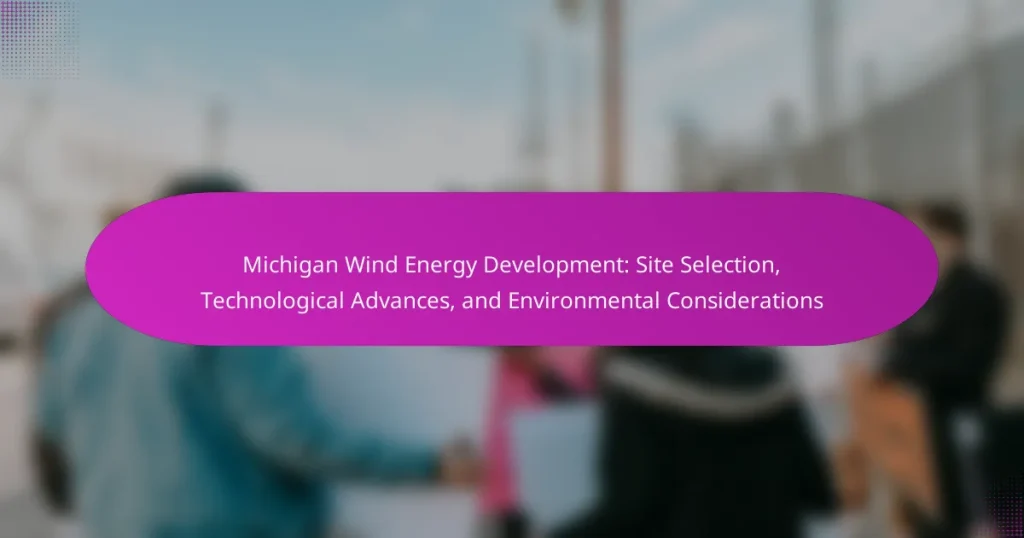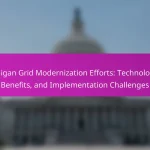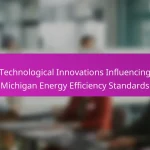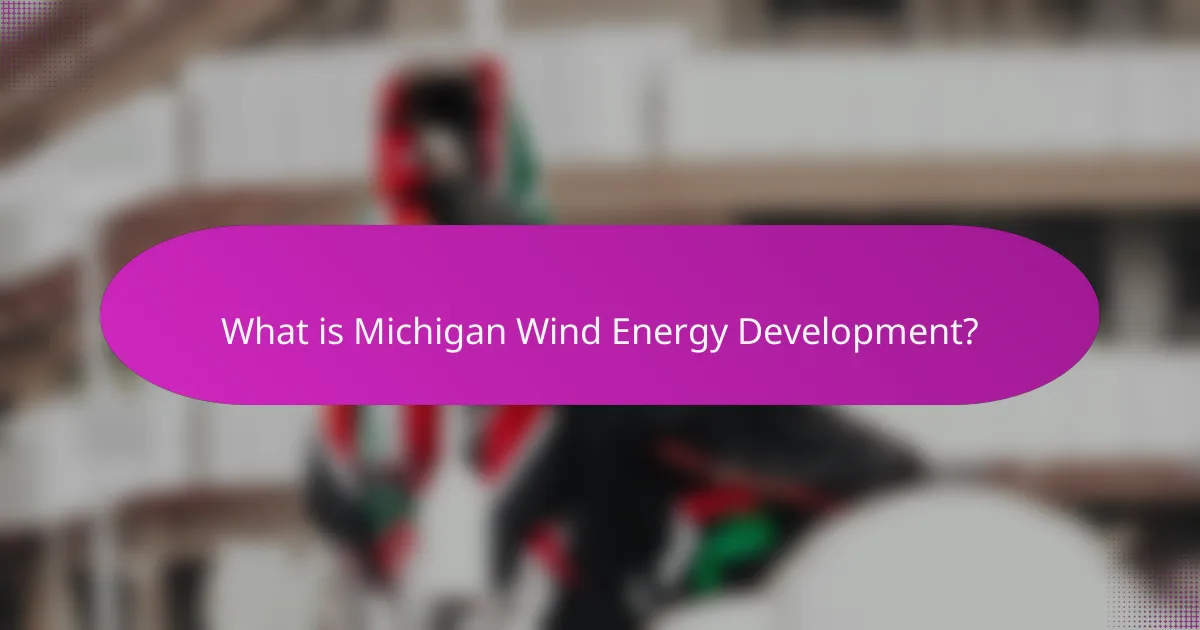
What is Michigan Wind Energy Development?
Michigan Wind Energy Development refers to the initiatives and projects aimed at harnessing wind energy in Michigan. This development includes the construction of wind farms and the installation of wind turbines across the state. Michigan has significant wind resources, particularly in the western and northern regions. The state has set goals for renewable energy, aiming for 15% of its energy to come from renewable sources by 2021. As of 2020, Michigan had over 1,300 megawatts of installed wind capacity. This capacity is expected to grow as more projects are proposed and developed. The development also considers environmental impacts and community engagement.
How does wind energy development impact Michigan’s energy landscape?
Wind energy development significantly transforms Michigan’s energy landscape. It increases the state’s renewable energy capacity. In 2022, wind energy accounted for approximately 10% of Michigan’s electricity generation. The growth of wind farms reduces reliance on fossil fuels. This transition helps lower greenhouse gas emissions. Additionally, wind energy creates jobs in manufacturing and installation. The development also stimulates local economies through land leases and tax revenues. Overall, wind energy enhances energy security and sustainability in Michigan.
What are the key components of wind energy systems in Michigan?
The key components of wind energy systems in Michigan include wind turbines, control systems, and energy storage solutions. Wind turbines convert kinetic energy from the wind into mechanical energy. Control systems manage the operation and efficiency of the wind turbines. Energy storage solutions, such as batteries, store excess energy generated during high wind periods. Additionally, transmission infrastructure is essential for delivering the generated electricity to the grid. These components collectively support the state’s wind energy generation efforts, contributing to Michigan’s renewable energy goals.
How does Michigan’s geography influence wind energy potential?
Michigan’s geography significantly influences its wind energy potential. The state’s location between two Great Lakes creates unique wind patterns. These lakes moderate temperatures and can enhance wind speeds, especially during seasonal changes. The flat terrain in many areas allows for unobstructed wind flow. Michigan’s elevation variations also contribute to localized wind effects. Areas like the Thumb and the west coast experience higher wind speeds due to geographic features. According to the U.S. Department of Energy, Michigan ranks among the top states for wind energy potential. This is supported by wind resource maps that highlight favorable regions for turbine placement.
What are the goals of wind energy development in Michigan?
The goals of wind energy development in Michigan include increasing renewable energy production and reducing greenhouse gas emissions. Michigan aims to generate 15% of its energy from renewable sources by 2021, with wind energy being a key contributor. The state also focuses on creating jobs in the renewable energy sector. Additionally, enhancing energy independence and stabilizing energy costs are important objectives. The development of wind energy supports local economies through investments and infrastructure improvements. These goals align with broader national initiatives to promote sustainable energy practices.
How does wind energy contribute to Michigan’s renewable energy targets?
Wind energy significantly contributes to Michigan’s renewable energy targets by providing a clean and sustainable power source. The state aims for 15% of its electricity to come from renewable sources by 2021. Wind energy accounts for a substantial portion of this goal. As of 2020, Michigan had over 1,300 MW of installed wind capacity. This capacity generates enough electricity to power approximately 400,000 homes. The growth of wind energy also supports job creation in manufacturing and installation. Furthermore, wind energy helps reduce greenhouse gas emissions. This aligns with Michigan’s commitment to combat climate change. Overall, wind energy is a critical component in achieving Michigan’s renewable energy objectives.
What economic benefits does wind energy bring to local communities?
Wind energy brings significant economic benefits to local communities. It creates jobs in manufacturing, installation, and maintenance of wind turbines. According to the U.S. Department of Energy, the wind sector employed over 116,000 workers in 2019. Local communities benefit from increased tax revenues from wind projects. These revenues can fund schools, roads, and other public services. Additionally, landowners receive lease payments, providing them with a steady income. Wind energy projects can stimulate local economies through increased spending in the area. Research indicates that for every megawatt of wind capacity, approximately $1 million is invested in local economies. Overall, wind energy contributes to economic growth and stability in communities.
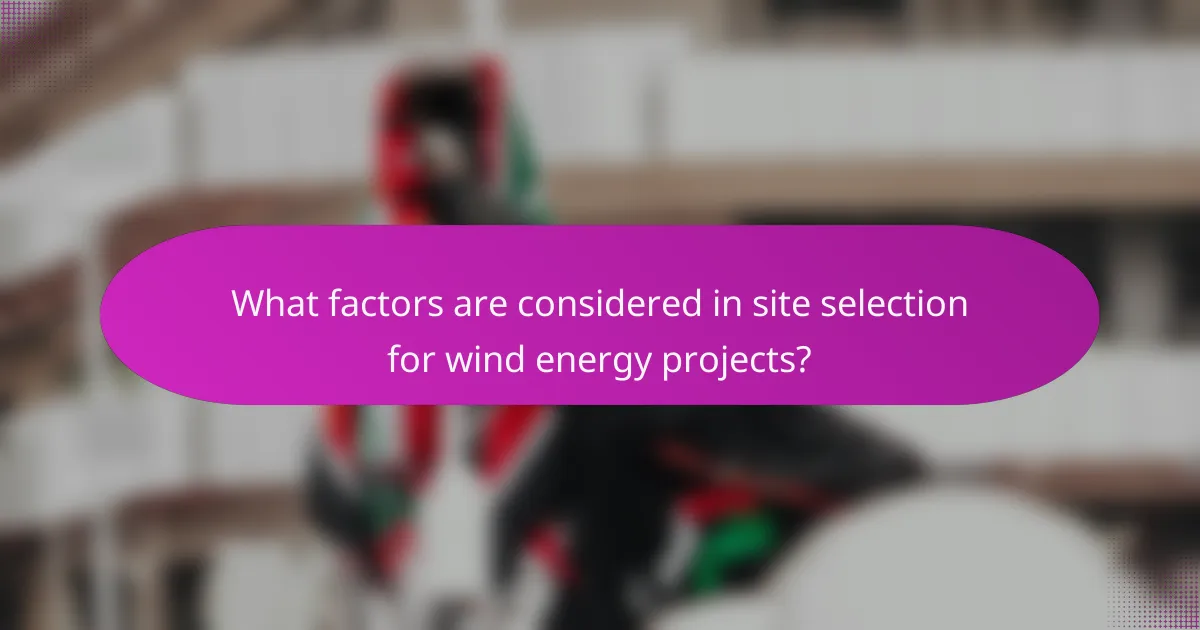
What factors are considered in site selection for wind energy projects?
Key factors in site selection for wind energy projects include wind resource availability, land use compatibility, and environmental impact. Wind resource availability is assessed through wind speed and consistency data. Land use compatibility considers existing land uses, zoning regulations, and potential conflicts with local communities. Environmental impact analysis evaluates effects on wildlife, ecosystems, and local habitats. Proximity to transmission lines is also crucial for efficient energy distribution. Additionally, the site’s accessibility for construction and maintenance influences the decision. These factors collectively ensure the project’s feasibility and sustainability.
How do environmental assessments influence site selection?
Environmental assessments significantly influence site selection for wind energy projects. They evaluate potential environmental impacts of proposed sites. Key factors include wildlife habitats, water resources, and land use. Assessments identify sensitive areas that require protection. For example, sites near endangered species habitats may be avoided. Regulatory compliance is also a critical consideration. Environmental assessments help developers meet legal requirements. They provide data for informed decision-making. Ultimately, thorough assessments lead to sustainable site selection that balances energy needs with ecological preservation.
What are the critical environmental considerations in wind farm placement?
Critical environmental considerations in wind farm placement include wildlife impact, land use, and local ecosystems. Wind farms can disrupt bird and bat migration patterns, leading to fatalities. Placement near sensitive habitats can threaten endangered species. The land use must consider agricultural practices and local communities. Noise and visual impacts also affect nearby residents. Additionally, the potential for soil erosion and water runoff must be assessed. Environmental impact assessments are essential to address these concerns before development.
How do wildlife and habitat assessments affect site decisions?
Wildlife and habitat assessments significantly influence site decisions for wind energy development. These assessments identify critical habitats and species present in the proposed area. They help determine potential environmental impacts of the wind project. Decision-makers use this information to mitigate risks to wildlife. For example, areas with endangered species may be avoided to comply with regulations. Additionally, assessments can lead to site modifications to minimize habitat disruption. By considering these factors, developers can align projects with environmental sustainability goals. This approach not only protects biodiversity but also enhances community acceptance of the project.
What role do community concerns play in site selection?
Community concerns significantly influence site selection for wind energy projects. Local opposition can delay or halt development. Engaging with community stakeholders fosters trust and addresses fears. Concerns often include noise, visual impact, and environmental effects. Research shows that projects with community support are more likely to succeed. For example, a study by the National Renewable Energy Laboratory found that community engagement reduces conflicts. Addressing these concerns early in the planning process leads to better outcomes. Ultimately, community acceptance is crucial for the long-term viability of wind energy projects in Michigan.
How can stakeholder engagement improve project acceptance?
Stakeholder engagement can significantly improve project acceptance by fostering collaboration and trust. Engaging stakeholders ensures their concerns are addressed early in the project. This proactive approach can lead to better project design and increased support. Research shows that projects with strong stakeholder involvement have up to 30% higher acceptance rates. In Michigan’s wind energy development, involving local communities can mitigate opposition and enhance project viability. Effective communication throughout the project lifecycle builds transparency and credibility. Ultimately, stakeholder engagement aligns project goals with community interests, leading to smoother implementation.
What are common community objections to wind energy projects?
Common community objections to wind energy projects include concerns about noise, aesthetics, and wildlife impacts. Residents often report that wind turbines create persistent noise, which can disrupt daily life. The visual impact of large turbines on landscapes is another significant concern for many communities. Additionally, there are fears regarding the effects on local wildlife, particularly birds and bats, which can be harmed by turbine blades. Property value reduction is also cited as a worry among homeowners near proposed sites. Finally, some communities express skepticism about the reliability and efficiency of wind energy compared to traditional energy sources.
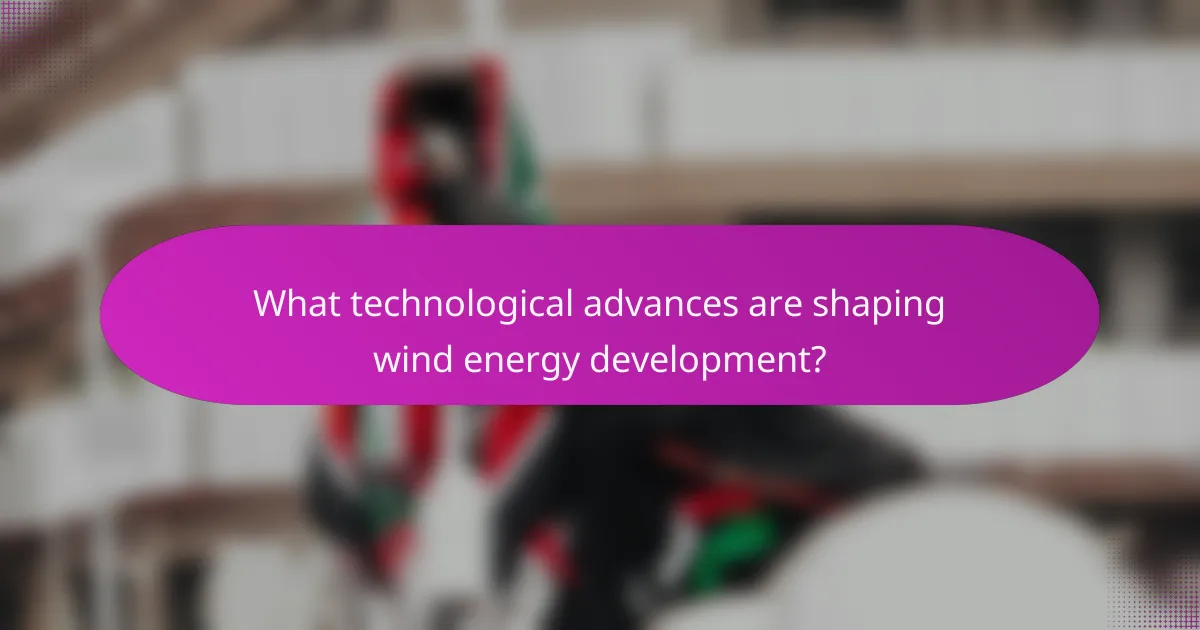
What technological advances are shaping wind energy development?
Technological advances shaping wind energy development include larger turbine sizes, improved materials, and enhanced energy storage solutions. Larger turbines capture more wind energy and increase efficiency. For instance, modern turbines can exceed 12 MW in capacity. Improved materials, such as lighter composites, enhance durability and reduce maintenance costs. Enhanced energy storage solutions, like lithium-ion batteries, allow for better energy management. These advancements contribute to lower costs and increased reliability in wind energy systems. According to the U.S. Department of Energy, the cost of wind energy has decreased by 70% since 2009 due to these innovations.
How have turbine designs evolved in Michigan?
Turbine designs in Michigan have evolved significantly over the past few decades. Initially, early models were smaller, with limited efficiency and capacity. Modern turbines are larger, reaching heights of over 500 feet and generating more than 2 MW of power each. The shift to horizontal-axis wind turbines has become prevalent due to their efficiency. Advances in materials have also contributed to lighter and more durable blades. Additionally, the integration of smart technology has improved turbine performance and monitoring. According to the American Wind Energy Association, Michigan’s installed wind capacity has grown from 1,000 MW in 2010 to over 4,000 MW by 2022. This evolution reflects a response to both technological advancements and the increasing demand for renewable energy.
What are the latest innovations in turbine efficiency?
Recent innovations in turbine efficiency include advanced blade designs and enhanced materials. These developments enable turbines to capture more wind energy. For instance, longer and lighter blades increase the swept area, improving energy capture. Additionally, the use of carbon fiber composites reduces weight while maintaining strength. Smart technology integration allows for real-time adjustments to optimize performance under varying wind conditions. Moreover, improved aerodynamics through computational fluid dynamics modeling enhances overall efficiency. The implementation of direct drive systems eliminates gear losses, further increasing energy output. According to the U.S. Department of Energy, turbine efficiency has improved by over 30% in the last decade due to these innovations.
How do smart grid technologies enhance wind energy integration?
Smart grid technologies enhance wind energy integration by improving the management of energy supply and demand. These technologies facilitate real-time monitoring and control of energy flows. They enable better forecasting of wind energy production, which allows for more accurate grid balancing. Smart grids also support distributed energy resources, integrating wind power with other renewable sources. This increases the reliability of energy supply. Additionally, smart grids enhance communication between producers and consumers, optimizing energy consumption patterns. According to the U.S. Department of Energy, these advancements can increase the share of renewable energy in the grid, leading to a more sustainable energy system.
What role does data analytics play in wind energy optimization?
Data analytics plays a crucial role in wind energy optimization by improving efficiency and performance. It enables the analysis of vast amounts of data from wind turbines and environmental conditions. This analysis helps in predicting energy output based on wind patterns. Additionally, data analytics assists in identifying maintenance needs to reduce downtime. It also optimizes turbine placement by evaluating site-specific factors. Research indicates that using data analytics can increase energy production by up to 10%. This quantifiable improvement demonstrates the effectiveness of data-driven strategies in wind energy management.
How can predictive maintenance improve wind farm performance?
Predictive maintenance can improve wind farm performance by anticipating equipment failures before they occur. This approach utilizes data analytics and machine learning to monitor turbine health. By analyzing historical performance data, potential issues can be identified early. This proactive strategy reduces unexpected downtime and maintenance costs. According to a study by the National Renewable Energy Laboratory, predictive maintenance can increase wind turbine availability by up to 10%. Enhanced availability directly correlates with improved energy production. Therefore, predictive maintenance optimizes overall wind farm efficiency and reliability.
What tools are used for wind resource assessment?
Wind resource assessment employs several tools. These tools include anemometers, which measure wind speed and direction. Lidar (Light Detection and Ranging) systems assess wind profiles at various heights. SODAR (Sonic Detection and Ranging) is another tool used for measuring wind speed and turbulence. Meteorological towers collect data over time to analyze wind patterns. Wind resource assessment software models wind data to predict energy production. Geographic Information Systems (GIS) help visualize wind resource data spatially. These tools collectively enhance the accuracy of wind resource evaluations.
What are the future trends in wind energy technology?
Future trends in wind energy technology include larger turbines, improved energy storage, and enhanced efficiency. Turbine sizes are increasing to capture more wind and generate more power. For instance, offshore wind turbines are now reaching over 10 MW in capacity. Energy storage advancements, such as battery technology, are crucial for managing intermittent energy supply. Additionally, digital technologies like AI and IoT are optimizing turbine operations and maintenance. The global wind energy market is projected to grow significantly, with investments expected to exceed $1 trillion by 2040. These trends indicate a shift towards more sustainable and efficient wind energy solutions.
How might offshore wind energy projects change Michigan’s landscape?
Offshore wind energy projects will significantly alter Michigan’s landscape. These projects will introduce large wind turbines into the Great Lakes. The visual impact will be substantial, as turbines can reach heights of over 600 feet. They will be visible from shorelines, changing the scenic views. Additionally, these projects will require infrastructure development, such as roads and ports. The construction phase will temporarily disrupt local ecosystems. However, in the long term, they may promote cleaner air and water. This shift towards renewable energy aligns with Michigan’s sustainability goals.
What advancements are expected in energy storage for wind energy?
Advancements in energy storage for wind energy are focused on improving efficiency and capacity. Innovations in battery technology, such as solid-state batteries, are expected to enhance energy density. Flow batteries are also gaining attention for their scalability and longer discharge times. Research into hydrogen storage is progressing, allowing excess wind energy to be converted into hydrogen fuel. Additionally, advancements in compressed air energy storage systems are being explored for better integration with wind farms. These technologies aim to address the intermittency of wind energy and provide reliable power supply. Recent studies highlight that these advancements could significantly reduce energy costs and improve grid stability.
What best practices should be followed in Michigan wind energy development?
Best practices in Michigan wind energy development include thorough site assessment, community engagement, and adherence to environmental regulations. Site assessments should evaluate wind resources, land use, and proximity to wildlife habitats. Engaging local communities fosters support and addresses concerns. Compliance with Michigan’s renewable energy standards ensures projects meet legal requirements. Conducting environmental impact assessments minimizes ecological disruption. Utilizing advanced turbine technology enhances efficiency and reduces noise. Regular maintenance of wind farms is essential for optimal performance. These practices contribute to sustainable and responsible wind energy development in Michigan.
Michigan Wind Energy Development encompasses initiatives to harness wind energy through the construction of wind farms and installation of turbines across the state, leveraging its significant wind resources. Key components include wind turbines, control systems, and energy storage solutions, all contributing to an increase in renewable energy capacity, job creation, and reduced greenhouse gas emissions. The article explores the impact of Michigan’s geography on wind energy potential, the goals of wind energy development, and the economic benefits for local communities. Additionally, it examines site selection factors, community engagement, technological advances, and best practices for sustainable development in Michigan’s wind energy landscape.
